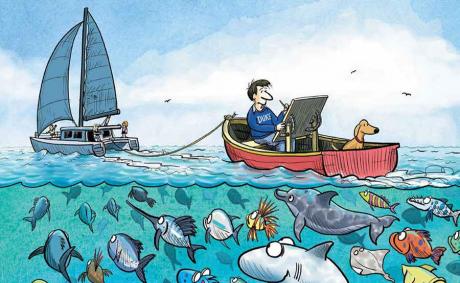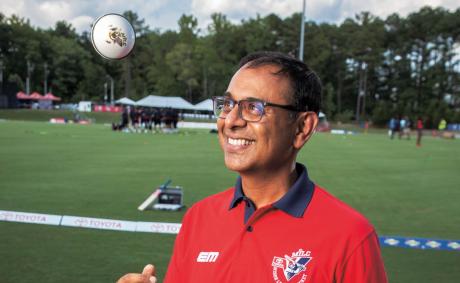When friends visited the Massachusetts home of Bruce Rosenbaum M.B.A.’88 and his wife, Melanie, they would quickly realize the furnishings in the Victorian house were anything but cookie-cutter. Dated items such as old wood-burning stoves and fireplace mantels were modernized through electricity and multifunctionality, yet remained loyal to their industrial aesthetic.
Recalling that memory, Rosenbaum laughs. “They said, ‘You know you’re steampunking, right?’ I was like ‘steam what?”’
Now an avid member of the steampunk community, Rosenbaum describes it as an art genre, design, and perspective that blends old and new aesthetics to create innovation. Specifically, aesthetics from the Victorian era’s industrial steam-driven machinery get a modern technological twist. Steampunk brings new life to outdated objects and ideas.

“Steampunk allows us to tell a story of past, present, future,” Rosenbaum says. “What it was, what it’s become, and what it will be.”
Originally inspired by the look of the 1960s TV show “The Wild Wild West,” Rosenbaum always had an appreciation for the quality, durability and design of objects of the Victorian period. He grew up in Marblehead, Massachusetts, and earned a bachelor’s degree in business from the University of Massachusetts Amherst. After completing his MBA at Duke, he worked in direct marketing until he realized he could merge his background in marketing and branding with his personal interest in artistry. In 2007, he founded his own art and design business, ModVic (Modern Victorian), and began his journey into the steampunk world.
“Steampunk allows us to tell a story of past, present, future.”
Bruce Rosenbaum
The process, Rosenbaum notes, was not without its trials and tribulations. Amid the 2007 Great Recession, he took a risk by purchasing and revamping a Victorian home. Like many others, he found himself trying to sell in a collapsed housing market. Ultimately, the bank auctioned the home, and Rosenbaum filed for personal bankruptcy.
“That time was a great life lesson,” he said. “We went through those challenges because adversity needs to be met. You need to pivot and move on.”
Rosenbaum cites his time at Duke’s Fuqua School of Business as a contributor to his turnaround.

“Duke helped prepare me for what I’m doing now. That is where I got my MBA, and during that time a lot of my focus was on entrepreneurship and business. I remember one of the courses had us create a new business with a team.”
Collaboration is part of the steampunk skill set. And more than just an aesthetically pleasing design or physical sculpture, the process of steampunk creation can change a person’s life. In 2013, Rosenbaum and Dr. Ashleigh Hillier, a psychology professor at the University of Massachusetts Lowell, created the program “Steampunkinetics: Building Art Into Science.” Spanning nine weeks, the workshop focused on using steampunk elements in an interactive and collaborative environment for students on the autism spectrum. The participants were assigned individual tasks that ultimately contributed to one large steampunk kinetic sculpture.
“We wanted to create a collaboration between art and psychology to increase social relationships among the students,” Hillier said. “Bruce’s creativity for the steampunk activities was so valued, and the results of the program were incredibly positive. Them working together for these hands-on tasks and gaining confidence was worthwhile alone.”
As for the bigger picture, Rosenbaum is excited and passionate about what the future of sustainability could look like with steampunk influences. For example, how could core parts of steampunk design – reusing, repurposing, and recycling existing materials – lead the way in sustainable initiatives to counter climate change.
“There is absolutely something here, and we’re continuing to make these connections in powerful
ways.”




